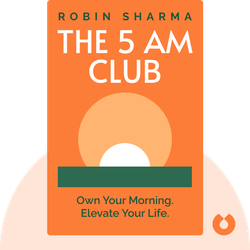Try Blinkist to get the key ideas from 7,000+ bestselling nonfiction titles and podcasts. Listen or read in just 15 minutes.
Start your free trial
Blink 3 of 8 - The 5 AM Club
by Robin Sharma

Letters that Changed the World
Written in History by Simon Sebag Montefiore takes readers on a journey through powerful and personal letters, diaries, and speeches of historical figures. Discover fresh perspectives on the famous and the lesser known, and witness the evolution of human emotions and aspirations over time.
Love letters aren’t only for infatuated teenagers. Some of the world’s most famous figures wrote reams of letters to their lovers – and some of their wooing techniques may even shock you.
Take Mozart, who had a most unusual approach to flirting with his cousin and probable lover, Marianne. Though his relationship with her irritated his father, there was no stopping the musical prodigy from pursuing his desires in his private letters. His method for stoking the sexual tension? Poo jokes.
Indeed, in one of his letters to Marianne, Mozart wrote that he wanted to put his personal letter seal on her rear end before letting out a “resounding fart.”
Letters to his wife Constance five years later take a more charming tone: “I get all excited like a child when I think about being with you again – if people could see my heart I should almost feel ashamed.” Apparently, the scatological approach was reserved for his cousin.
For centuries, letters often facilitated affairs. Private letters enabled writers to convey their lust with candor and reassure the objects of their desires.
For example, the aristocratic poet Vita Sackville-West composed love letters to the writer Virginia Woolf, assuring her that Woolf held a special place in her heart despite her many other lovers.
Her desire for Woolf is written in honest and uncomplicated terms: “I just miss you, in a quite simple, desperate human way.” She criticizes herself for being incapable of crafting a letter in the elegant standard of Woolf’s writing. Yet perhaps the raw sincerity of her words is more potent and poetic than a wordier, embellished alternative.
But love letters weren’t only the works of artists; dictators penned their deepest passions, too.
In 1912, a letter written by a 32-year-old Joseph Stalin to his 16-year-old mistress, whom he had met while exiled in the Russian countryside, offers a glimpse into the soon-to-be tyrant’s surprising capacity for romance: “I’m …. kiiissssing you passionately (it’s not worth kissing any other way), Josef.”
The affection displayed in the letter is hard to reconcile with the narrative of a man we know for terrorizing his country through mass murder.
From Stalin’s playfulness to Mozart’s toilet banter, love letters have revealed otherwise unbelievable sides of history’s most influential people.



Written in History (2018) takes a look at some of the world’s most important letters. From love letters revealing the intimate sides of Mozart and Stalin to political statements which altered the course of history, these blinks guide you through the personal thoughts of many renowned figures of the past. As you’ll see, letters give us insight into historical events as well as remind us what it means to be human.
Written in History (2019) by Simon Sebag Montefiore is an engaging collection of letters that provides a captivating glimpse into some of the most significant moments in history. Here's why this book is worth reading:
Well adieu my Angel my heart Im waiting for you PS Shit-dibitare, shit-dibatate, the pastor of Rodempl, he licked the ass of his kitchen maid, to set a good example. – Mozart to Marianne.

It's highly addictive to get core insights on personally relevant topics without repetition or triviality. Added to that the apps ability to suggest kindred interests opens up a foundation of knowledge.
Great app. Good selection of book summaries you can read or listen to while commuting. Instead of scrolling through your social media news feed, this is a much better way to spend your spare time in my opinion.
Life changing. The concept of being able to grasp a book's main point in such a short time truly opens multiple opportunities to grow every area of your life at a faster rate.
Great app. Addicting. Perfect for wait times, morning coffee, evening before bed. Extremely well written, thorough, easy to use.
Try Blinkist to get the key ideas from 7,000+ bestselling nonfiction titles and podcasts. Listen or read in just 15 minutes.
Start your free trial
Blink 3 of 8 - The 5 AM Club
by Robin Sharma
What is the main message of Written in History?
The main message of Written in History is the power of firsthand accounts in shaping our understanding of historical events.
How long does it take to read Written in History?
The reading time for Written in History can vary depending on the reader, but it typically takes several hours. However, the Blinkist summary can be read in just 15 minutes.
Is Written in History a good book? Is it worth reading?
Written in History is a captivating book that offers unique insights into key historical moments. It is definitely worth reading.
Who is the author of Written in History?
Written in History is written by Simon Sebag Montefiore.